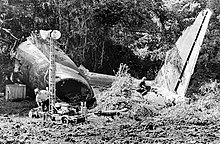Eastern Air Lines Flight 212
 | |
| Accident | |
|---|---|
| Date | September 11, 1974 |
| Summary | Pilot error |
| Site | Charlotte, North Carolina, United States 35°09′14″N 80°55′34″W / 35.15389°N 80.92611°W |
| Aircraft type | Douglas DC-9-31 |
| Operator | Eastern Air Lines |
| Registration | N8984E[1] |
| Passengers | 78 |
| Crew | 4 |
| Fatalities | 72 (69 initially, 3 died later) |
| Injuries | 10 |
| Survivors | 10 (13 initially, 3 died later) |
Eastern Air Lines Flight 212 was an Eastern Air Lines Douglas DC-9-31, carrying 78 passengers and four crew, operating as a scheduled flight within the United States from Charleston, South Carolina to Chicago, Illinois, with an intermediate stop in Charlotte, North Carolina. On the morning of September 11, 1974, while conducting an instrument approach in dense ground fog into Douglas Municipal Airport (now called Charlotte/Douglas International Airport), Charlotte, North Carolina, the aircraft crashed just short of the runway, killing 72 on board. Thirteen people survived the initial impact, including the co-pilot and one flight attendant. However, three more ultimately died from severe burn injuries.[2] One of the initial survivors died of injuries 29 days after the accident. Among those who died were the father and two older brothers of future American comedian Stephen Colbert;[3] Navy Rear Admiral Charles W. Cummings, acting commandant of the 6th Naval District; three executives of Charleston's The Post and Courier (production manager Lewis Weston, circulation manager Charles McDonald, and mail room supervisor Jack Sanders); television anchorman Wayne Seal of WCIV in Sullivan's Island, South Carolina; and John Merriman, news editor for the CBS Evening News.[2][4]
The accident was investigated by the National Transportation Safety Board (NTSB), which released its final report[5] on May 23, 1975. The NTSB concluded that the accident was caused by the flight crew's lack of altitude awareness and poor cockpit discipline.[6]
Crash investigation and recommendations
While investigating this accident, and reviewing the cockpit voice recorder (CVR), the NTSB found that the flight crew engaged in unnecessary and "impertinent" conversation during the approach phase of the flight, discussing subjects "ranging from politics to used cars".[5] The NTSB concluded that conducting such non-essential chatter can distract pilots from their flying duties during the critical phases of flight, such as instrument approach to landing, and recommended that the FAA establish rules and educate pilots to focus exclusively on flying tasks while operating at low altitudes. The FAA, after more than six years of consideration, finally published the Sterile Cockpit Rule in 1981.[7][8]
Another possible cause of the crash discussed by the NTSB in its review of the CVR was that the crew was apparently trying to visually locate the Charlotte airport, while executing an instrument approach in the presence of low-lying fog. In addition, a persistent attempt to visually identify the nearby Carowinds amusement park tower,[9] known as "Carowinds Tower" to pilots, rising to 1,314 feet (401 m) MSL (340 feet (100 m) AGL), may have further distracted and confused the flight crew. None of the required altitude callouts were made by the captain, which compounded the flight crew's near total lack of altitude awareness.
During the investigation the issue of the flammability of passengers' clothing materials came up. There was evidence that passengers who wore double-knit artificial-fiber clothing articles sustained significantly worse burn injuries during the post-crash fire than passengers who wore articles made from natural fibers.[5]
The NTSB issued the following official Probable Cause statement for the accident:[6]
The flight crew's lack of altitude awareness at critical points during the approach due to poor cockpit discipline in that the crew did not follow prescribed procedure.
See also
- List of accidents and incidents involving commercial aircraft
- Air safety
- Controlled flight into terrain
- Ground proximity warning system
References
- ^ "FAA Registry (N8984E)". Federal Aviation Administration.
- ^ a b Florence Morning News South Carolina, September 12, 1974. Archived at GenDisasters.com. Retrieved 2008-03-15.
- ^ "Stephen Colbert On Insincerity", 60 Minutes, April 27, 2006
- ^ Kropf, Schuyler (September 11, 2009). "Today a grim reminder of Charleston lives lost in crash". The Post and Courier. Charleston, South Carolina. Archived from the original on September 14, 2009. Retrieved 14 September 2009.
- ^ a b c Air Accident Report 75-9, (PDF) NTSB, May 23, 1975. Archived at AirDisaster.com. Retrieved 2009-03-17.
- ^ a b Accident description at the Aviation Safety Network
- ^ The Sterile Cockpit NASA Aviation Safety Reporting System Directline, #4 : June 1993. Robert L. Sumwalt. Retrieved 2007-04-22.
- ^ The Cockpit, the Cabin, and Social Psychology Airlinesafety.com 2005. Robert Baron. Retrieved 2007-04-22
- ^ "Carolina Skytower". Theme Park Insider website. Retrieved 2006-10-08.
External links
- Airliner accidents and incidents caused by pilot error
- Airliner accidents and incidents in North Carolina
- Aviation accidents and incidents in the United States in 1974
- 1974 in North Carolina
- Eastern Air Lines accidents and incidents
- Disasters in North Carolina
- Accidents and incidents involving the McDonnell Douglas DC-9
- History of Charlotte, North Carolina
